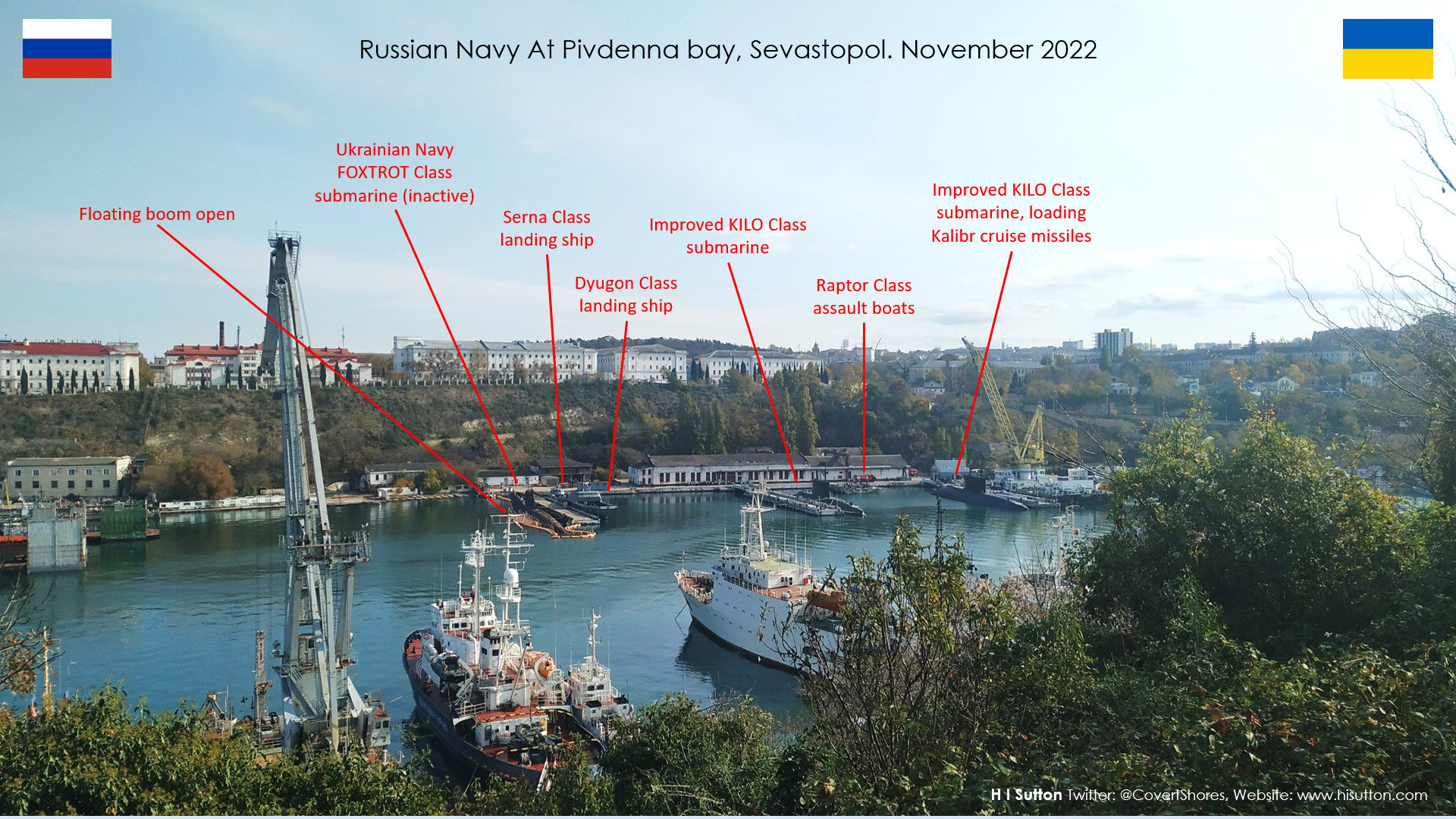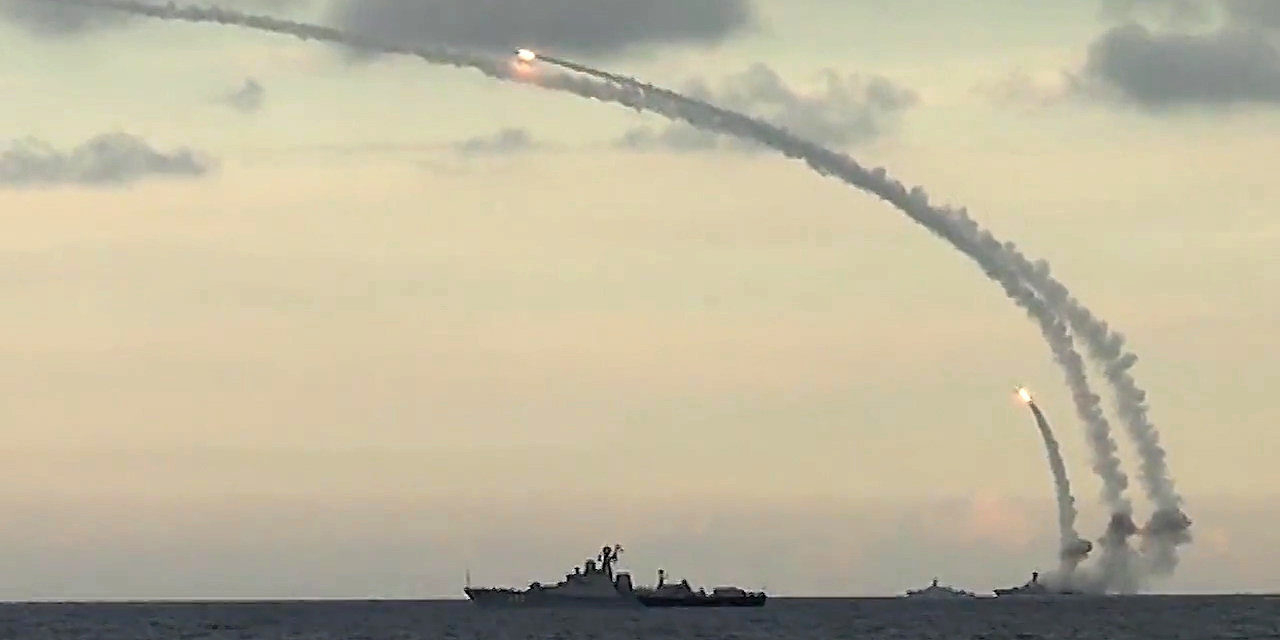The Russian Navy appears to be on the back foot after the Ukrainian attack on the Russian Black Sea Fleet on October 29 involving several unmanned aerial and surface vehicles.
Nevertheless, the Russian Black Sea Fleet has been keeping at least one Kalibr-capable vessel on active combat duty, according to Ukrainian Navy.
As per the information from the Russian defense ministry, 16 Ukrainian drones were involved in the Sevastapol attack on October 29, including nine unmanned aerial vehicles (UAV) and seven autonomous maritime drones.
Following the attack, both of the Black Sea Fleet’s Admiral Grigorovich-class frigates, which are the largest and most capable ships in the fleet as of present, have mostly been in port, according to Independent Naval Analyst H.I. Sutton.

One of these, Black Sea flagship Admiral Makarov, is believed to have sustained some damage during the October attack.
#Ukraine: Remarkable video of today's attack on the Russian Sevastopol Naval Base.
Ukrainian Uncrewed Surface Vessels (Drone boats filled with explosives) apparently managed to hit a Project 11356R frigate (presumably Admiral Makarov) & the Ivan Golubets Project 266M minesweeper. pic.twitter.com/6nJVkwvgKW— ?? Ukraine Weapons Tracker (@UAWeapons) October 29, 2022
That said, the Black Sea Fleet has been keeping at least one Kalibr-capable vessel on active combat duty, according to the information released by the Ukrainian Navy.
Apart from the two Admiral Grigorovich-class frigates, the Black Sea Fleet has four Buyan-M corvettes that can fire Kalibr missiles.
The attack on the Black Sea Fleet was said to be in retaliation to the Russian military’s large-scale missile and drone attacks across Ukraine.
As per the Ukrainian Air Force estimate, Russia fired over 83 missiles in its attacks across Ukraine on October 10 after the attack on Kerch Bridge. The scale of the missile assault was undoubtedly much more extensive than has been observed in recent months of the conflict.
Ukrainian Air Force spokesperson Yurii Ihnat said that the missiles fired by Russia included high-precision missiles, which are difficult to counter, such as the Kalibre, Kh-101, and Iskanders. However, the Ukrainian Air Force managed to destroy 43 of the 83 missiles fired, Ihnat claimed.
“Out of 43 missiles, more than half were destroyed by our air defense. Considering the means we have in our arsenal today, this is an extremely high indicator,” Ihnat said.
Also, a senior US Defense official revealed during a background briefing shortly after these missile attacks, “We did get indications yesterday of some Kalibr missiles being fired from the sea, and our understanding is that they were all intercepted by the Ukrainian air defenses. And then we continue to train.”
The official did not disclose where these Kalibr missiles were fired or what the Ukrainian military used for air defense to intercept the missiles.

Ukraine Intercepted All Kalibr Missiles
It is impossible to independently verify the estimates provided by the Ukrainian Air Force spokesperson. However, Ukrainian sources have uploaded videos to social media purportedly showing what appears to be the 3M-54 Kalibr cruise missile exploding mid-flight.
Ukrainian air defence destroys a Russian 3M-54 Kalibr cruise missile mid-flight, moments before impact. pic.twitter.com/Gp1bhZvhHP
— Jimmy Rushton (@JimmySecUK) October 18, 2022
According to a senior US defense official, four Kalibr missiles were fired from the Russian naval ships deployed in the Black Sea. “So we think there were four [missiles] fired yesterday from the Black Sea, and of those four, we believe all four were intercepted,” the official said in the background briefing.

The official noted that about a half-dozen Russian warships are underway in the Black Sea, and about half of those are Kalibr-capable.
The 3M-14 Kalibr Cruise Missile
The 3M-14 Kalibr (NATO designation: SS-N-30A) is a land attack cruise missile (LACM) developed by the Yekaterinburg-based Novator design bureau (part of the Almaz-Antey Group). It can be fired from surface vessels or submarines toward land targets.
According to the CSIS Missile Defense Project, the missile can travel at a maximum range of around 2500 kilometers.
While Russian defense officials have touted the Kalibr cruise missile as having near-zero probable circular error, a Russian military journalist noted in 2017 that the missile had an accuracy of 30 meters.
The Kalibre missile is designed to evade the enemy air defense and strike stationary ground targets. It can fly autonomously and horizontally at low altitudes along the pre-programmed waypoints.
The route of the missile can be updated mid-course via satellite communication. It is reportedly armed by a high explosive warhead weighing 453.59 kilograms.
As EurAsian Times reported earlier, the missile is generally used for attacking storage facilities, command posts, seaports, and airports.
The Russian military first employed the Kalibr missile in October 2015, when 26 missiles were fired from Russian naval vessels in the Caspian Sea at the rebel forces fighting against the Moscow-backed government of Syrian President Bashar al-Assad.
As per the estimate by the Russian Defense Ministry, Russian forces employed Kalibr cruise missiles 13 times, launching at least 99 munitions against rebel forces.
According to the figures presented by the “7,62 Project,” which tracks the Russian military operations in Ukraine, 33% of the missiles fired by Russia in the first month of its invasion of Ukraine were 3М-14 missiles of the Kalibr cruise missile family.
However, after March, Russian stocks of precision-guided missiles appeared to be dwindling, and the Russian Armed Forces began increasingly employing the old Soviet-designed missiles.
The Russian government has been taking measures to replenish the diminishing missile stockpile. For example, since May, two missile plants have reportedly been working more actively than others, including the Novator plant that manufactures Kalibre missiles.
The plant is said to have received additional funds and has reportedly been working round the clock in three shifts. It is known to produce around 100-120 Kalibr units per year and several dozen cruise missiles for the Iskander system.
Nevertheless, the factory is struggling to increase production volume, as it would require additional engineers, mechanics, and other technical workers.
- Contact the author at tanmaykadam700@gmail.com
- Follow EurAsian Times on Google News




